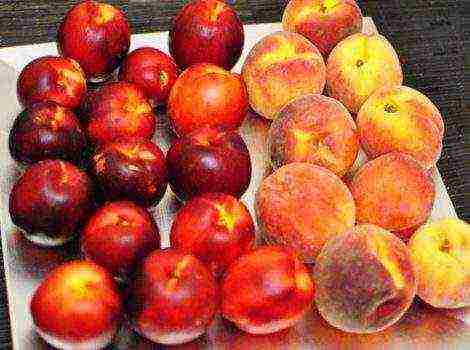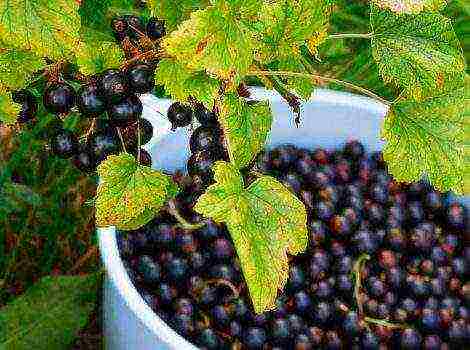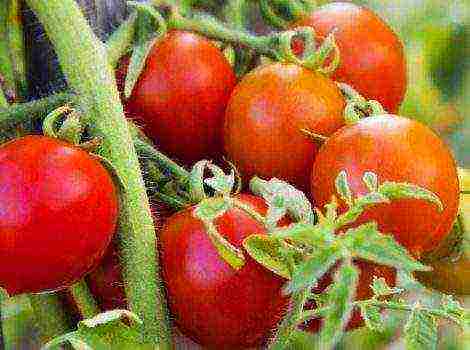Content
- 1 What are beans
- 2 Varieties popular among Russian gardeners
- 3 How to choose a variety for your region
- 4 Reviews
- 5 Varietal features
- 6 The best bush varieties
- 7 The best curly varieties
- 8 For lovers of exotic
- 9 Video tips for growing beans
- 10 Types of beans according to the structure of the bush - photo and description
- 11 Types of beans by method of use - names, photos and descriptions
Beans are a crop from the legume family. It is grown not only on an industrial scale, but also by amateur gardeners on their backyards. The homeland of the plant is South America, therefore, as you might guess, it is quite thermophilic. But modern varieties bred by breeding differ from the "original", including in greater cold resistance, therefore they successfully take root and yield crops not only in central Russia, but also in Siberia, in the Urals. The culture is rapidly gaining popularity among vegetable growers, as it is tasty and healthy.
What are beans
In nature, there are about 250 varieties of beans, and there are many more varieties and hybrids bred by breeding. Botanists and gardeners classify them according to various criteria.
Based on the appearance of the plant, beans are:
- bush. A low-growing compact plant, the height of adult specimens does not exceed 45–60 cm (in some varieties, only 25–30 cm). It is this type that is most in demand by those who grow beans on an industrial scale, since it allows you to significantly save space when planting. Also, bush beans are valued for their lack of care and cold resistance. It is even suitable for growing in Siberia. Fruits ripen earlier than in other varieties, and "together", almost simultaneously;
- curly. Liana-like plant with a thin stem, stretching up to 5-6 m in length. For the vast majority of varieties, a long vegetative period is characteristic, therefore, in the Urals and Siberia, when planting in the open field, the gardener will most likely simply not wait, especially if the summer is not very pleasing in terms of the weather. If you grow such vines on a trellis, they take up very little space. There are also decorative varieties that can be used in landscape design, for example, to create "wings", "green walls";
- half-wriggling. It does not differ from the previous variety in almost nothing with one exception: the length of the stem does not exceed 2 m.
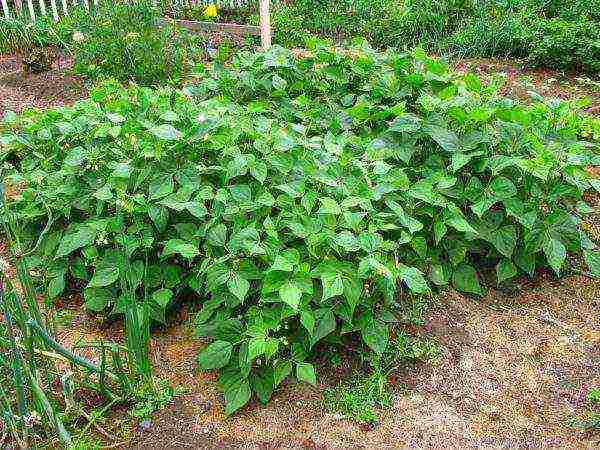
Bush beans are a fairly compact plant.
Beans can have edible beans themselves or whole pods. Interestingly, beans used to be considered rough food, suitable exclusively for the common people. But the pods were very popular with the aristocracy. Depending on which part of the plant is used for food, beans are:
- grain (shelling). Only beans are edible in such species. Even young pods are very tough and unsuitable for food. But the beans are extremely tasty and nutritious. Often, due to the color, they look very unusual, so the dishes turn out to be interesting and elegant.Almost all colors of the spectrum are present in the palette - from white and pale yellow to red, dark purple and almost black, including any shades of green. There are also varieties with variegated beans. The tough pod provides good keeping quality and transportability. Interestingly, in Europe and the post-Soviet space, white and green beans are more popular, and in America and Asia, varieties with dark beans are held in high esteem;
- asparagus (vegetable). The whole pod is eaten whole. This variety also has one more name - sugar beans. The pods, even when fully ripened, retain their softness, no hard bloom, similar to hardened wax, appears. They can even be eaten raw. The beans are also soft and tender. They are pretty small. Such beans are used not only for preparing the first and second courses, they can be canned and frozen, including at home;
- semi-sugar. Quite a small group of varieties. In young beans, the whole pod is eaten, when it is fully ripe, it is already inedible. After ripening, you can only eat beans. The pod becomes very tough, coarse fibers appear in it.
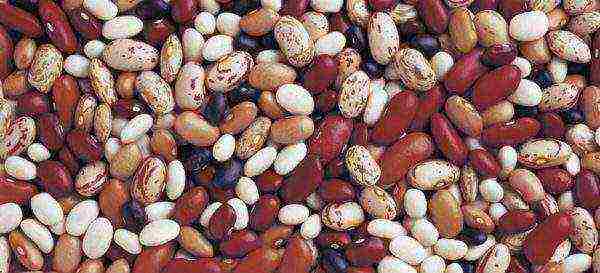
Beans in different varieties of beans vary greatly in shape, size and color.
There are also other classifications. In terms of ripening, beans can be early, mid or late ripening. In Russia, mainly the first two varieties are planted so that the crop has time to ripen even in a temperate climate. Early bean beans ripen in 50–65 days or even faster. In mid-ripening varieties, the vegetative period is 75–80 days, and in late-ripening varieties - 3 months or more.
If you take the mass of beans as a criterion, beans can be small, medium, and large. In the first case, a thousand pieces weigh no more than 200 g, in the second - 200-400 g. Large beans are considered with a mass of 400 g or more.
When choosing a variety, it should be borne in mind that red beans owe their color to a high content of antioxidants. These substances effectively remove toxins from the body, slow down the aging process, and stimulate cell renewal. White is notable for its low protein content, but it is very high in iron. It is very useful for those who want to lose weight, as well as for the elderly. Black beans are characterized by a record high content of amino acids, vitamins and trace elements. With regular consumption of food, metabolism and the work of the gastrointestinal tract are normalized.
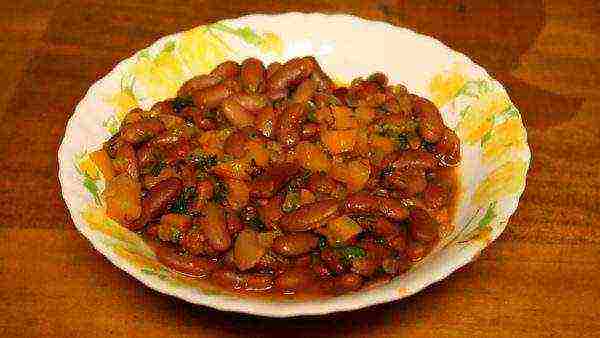
Beans are not only healthy, but also very tasty.
Not only edible but also ornamental beans are cultivated. Some varieties do not even bring a harvest, but they bloom very beautifully and profusely. Plants are both annual and perennial.
In those varieties that do form pods, the color of the beans necessarily matches the shade of the petals. The most popular among gardeners are varieties with bloody scarlet flowers.
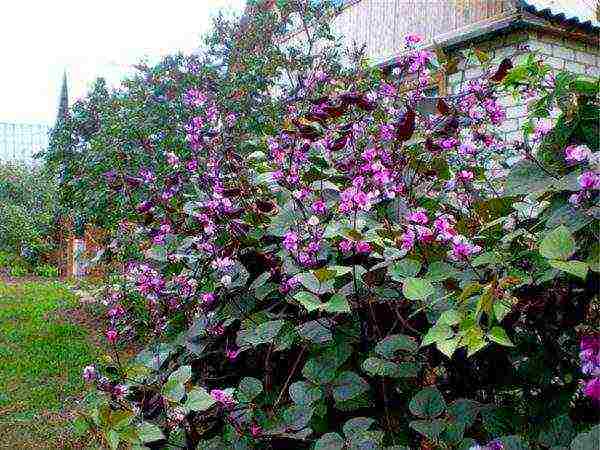
Beans can be grown not only for the sake of the harvest, but also for the purpose of decorating the garden plot
Video: health benefits and harms of beans
In addition to American beans (genus Phaesolis), familiar to gardeners for a long time, there is also its Asian "relative" (genus Vigna). It has been rapidly gaining popularity lately. From the point of view of botanists, it is still not a bean, but the opposite opinion has taken root among the people. Its main difference is the size of the pods. In length, they reach 80-100 cm, each with 2-3 dozen beans.
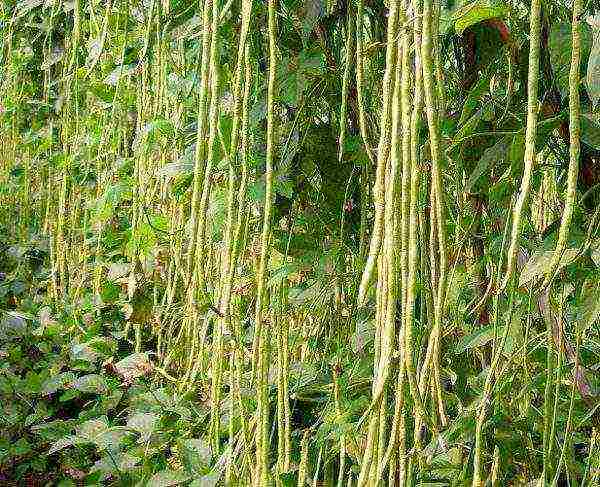
Vigna is a close "relative" of beans, but from the point of view of botanists they are still two different cultures
Varieties popular among Russian gardeners
There are a lot of varieties of beans, so a preliminary study of their description, advantages and disadvantages can make the choice.
Bush beans
Russian gardeners got acquainted with beans relatively recently, but they appreciated this culture very quickly. The most popular with them are bush asparagus varieties, but other varieties are also grown:
- Sachs without fiber 615.The variety was created in the USSR back in the 40s of the last century. Large beans of early ripening, pods are formed in 45-50 days. They grow up to 9–12 cm in length, slightly curved. Lime beans. The plants are very compact, the height of the bush does not exceed 35–40 cm. Each pod contains 4–10 beans weighing 5–5.2 g. The variety is valued for its good yield (over 2 kg / m²). This is achieved due to the fact that there are 6-10 pods in each sinus. The presence of good immunity against diseases typical of the culture, especially those caused by viruses and bacteria, and anthracnose is also noted. Beans are high in vitamin C and amino acids;
- The oil king. Another extremely popular early maturing variety. One of the recent achievements of breeders. Ripens almost at the same time as Saksa. Suitable for outdoor cultivation in temperate climates. Plant height up to 40 cm, compactness allows you to place 30–35 bushes per 1 m². The flowers are white. The pods are rather large (up to 20–25 cm in length), but thin (1.5–2 cm in diameter), honey-yellow in color. Each contains 4-6 beans. Their weight reaches 4-5.1 g, they are considered large. The variety is suitable for both cooking and canning. The yield is not bad - 2.1–2.3 kg / m²;
- Purple Queen (also known as Purple Lady, Red Duchess, Purple Queen). A mid-season bean variety that is appreciated by gardeners for its extreme ease of care, as well as for its excellent taste. It takes root successfully and brings a bountiful harvest in almost any substrate. The flowers are lilac-pink. The pods are about 15 cm long and have a deep purple color. During heat treatment, they change the shade to dark green. The average weight of the beans is 4.5–6.6 g. The yield varies from 1.6 kg / m² to 3 kg / m²;
- Nagano. An ultra-early Dutch variety, beans ripen in 40–45 days. You can sow these beans in open ground already in mid-May. The variety is distinguished by unpretentious care, resistance to diseases typical of the culture. The pods reach a length of 12-14 cm and are deep green in color. The beans are white or white-green, each containing 4-10 pieces. They weigh about 3.5 g. Average yield - 1.2 kg / m²;
- Bona. Variety from the mid-early category. Originally from Poland. Recommended by the state register for cultivation in the Central region. When planted on time, the crop is harvested in July. It ripens in 45–78 days. The flowers are white. In each axil of the leaf 3–10 green pods 12–15 cm long are formed. Each of them contains 4–6 white glossy beans. The yield is not bad, but not a record one - 1.4 kg / m². The pods are very tender and are good for fresh consumption. The variety is valued for the stability of fruiting, good immunity, suitability for mechanized harvesting;
- Inga. Ultra-early high-yielding bean variety. The growing season is only 45–48 days, you can count on more than 2 kg of beans per 1 m². The pods are pale green, short (8–10 cm), about 2 cm in diameter. Each has 4–10 barrel-shaped beans. Differs in versatility of purpose and compactness of the bush. Its height does not exceed 35 cm;
- Note. Beans of medium ripening. The duration of the vegetative period is 56–59 days. Due to its very high (3.3–3.4 kg / m²) yield, the variety is popular among those who grow crops on an industrial scale. The height of the bush is 35–40 cm. Up to 18–25 bright green pods 12–15 cm long and about 0.8 cm in diameter are formed in the axil of each leaf. The beans are brownish, weighing 2.6 g;
- Cinderella. Early ripe beans. The height of the bush reaches 50–55 cm. The flowers are large, bright pink. The pods are yellowish, slightly curved, 12–14 cm long and about 0.5 cm in diameter. The pods are elliptical, white. Productivity is about 1.7 kg / m². The variety has an "innate" immunity to bacteriosis and anthracnose;
- Dewdrop. The vegetative period is about 2 months (if you are lucky with the weather, the beans ripen faster).The bush grows up to 35–40 cm in height. The pods are light yellow, 10–12 cm long. The beans are snow-white, medium-sized, weighing about 3 g. The variety does not differ in high yield. 1.2 kg of beans ripens per 1 m²;
- Siesta. Early ripening variety. The bushes are undersized, up to 45 cm. The pods are sunny yellow, 12–14 cm long. The beans are white or cream, weighing 4.5–5 g;
- Aida Gold. The pods and beans are golden yellow in color. Dwarf bushes, up to 40 cm. Low yield - 1.1–1.3 kg / m². Suitable for outdoor and greenhouse cultivation. The ripening period for beans is highly dependent on the weather, it can vary from 1.5 months to 70-75 days. Even fully ripe pods do not crumble for a long time;
- Sugar triumph 764. The harvest ripens in 50–65 days. The height of the bush is no more than 40 cm. The flowers are crimson. The pods are light green, slightly flattened, very juicy, 12–16 cm long. The beans are yellow. The yield is not bad - 2 kg / m² or slightly less. The variety is relatively rarely affected by pathogenic fungi;
- Moscow white green-leafed 556. Mid-season variety, the harvest ripens in 50–65 days. Plants are no more than 30–35 cm in height. Lime-colored leaves, glossy. The pods are bright green, 9–11 cm long, the beans are snow-white. The variety is valued for its excellent taste, it tolerates both lack and excess of moisture;
- Tatyana. Early beans. The plant is 45-50 cm high. The flowers are large, bright purple. The pods are bright yellow, curved. The beans are almost black, medium to large in size. Their taste is amazing, but the yield, unfortunately, is low - 0.73 kg / m².
Photo gallery: varieties of bush beans
Black Eyed Peas
Asparagus beans can be either bush or curly. Both varieties are quite popular with gardeners.
- Golden nectar. Curly beans. It matures in an average of 2 months. Pods are about 25 cm long, golden, pods are pale yellow. It is often grown to decorate the site. The flowers are very beautiful golden orange in color. Due to the severity of the crop, it definitely needs a trellis or other support;
- Winner (Turkish Beans). A late-ripening variety, the harvest will have to wait at least 3 months. Compared to other varieties, this variety of curly beans is quite capricious in its care. It is especially demanding on heat, therefore it is sown late enough, when the probability of recurrent spring frosts is minimal. When planting between the plants, you need to leave at least 30 cm, the lashes are strongly spreading. The pods are bright green, 20-30 cm long. The flowers are most often bright scarlet, but can be crimson or pale pink, often there are white streaks and spots on the petals. Flowering is very abundant, it lasts from June to September. Pods are pale lilac, pinkish or almost white with a pattern of brown-black spots or monochromatic;
- Sweet courage. Early beans from the bush category. The height of the plants does not exceed 40 cm. The flowers are snow-white. The harvest ripens in 45–55 days, very amicably. The pods are bright yellow, cylindrical, slightly curved, reaching 15–16 cm in length. The beans are snow-white, medium-sized (about 3 g). The yield is not bad, 1.8–3.3 kg / m²;
- Crane. An early bush variety. The crop ripens in an average of 50 days. Plants are compact, 40–52 cm high. The variety is easy to care for. Designed mainly for winter freezing and canning. The length of the bright green pod is 11.7–13 cm, the diameter is up to 1 cm. The beans are snow-white, weighing 2.9–3.2 g. The yield is not too high - 0.9–1.3 kg / m². The variety is not affected by bacteriosis;
- Panther. One of the most common varieties of asparagus beans. The height of the bush is up to 40 cm. The beans ripen in 2 months or a little more. Fruiting is amicable. It is advisable to plant seeds in a well-warmed substrate. The beans are yellow and fleshy. The pods are slightly paler, curved, up to 15 cm in length. The variety has a very high immunity to bacteriosis and anthracnose. Also appreciated for its good yield (over 3 kg / m²).
Photo gallery: popular varieties of asparagus beans
Curly beans
Climbing beans can be grown not only for the sake of harvesting, but also as a stage crop if other plantings need to be shaded.
- Blauchilde (Bluhilda). A very powerful vine, which definitely needs support. The lashes grow up to 5 m in length, the pods - up to 25 cm. The pods and flowers are inky purple, over time the leaves also acquire a lilac hue. The crop ripens in 95-110 days. These beans begin to bloom quite early, flowering continues almost until the first frost. Harvest on time - overripe pods become harsh. When heat treated, they turn green. The beans are lined, weighing about 5 g, creamy beige. After cooking, they become a little oily;
- Turkish Woman (also known as Fiery Red). Mid-season variety of asparagus beans. The length of the liana is 3–3.5 m. Thick foliage is characteristic. The stems are thin. The flowers are snow-white. The length of the flattened pods is 18 cm, the diameter is slightly more than 2 cm. They are painted in a salad color with inky purple spots. The average yield is 4–4.5 kg / m². The variety almost never suffers from bacteriosis and anthracnose;
- Harmony. Semi-sugar beans. The variety has an average ripening period (65–80 days). Differs in unpretentiousness in care and yield stability. Fruiting is extended, continues until the first frost. The length of the vine is 3-4 m. The pods are pale golden, about 20 cm long. The yield per plant is 0.3-0.5 kg of snow-white beans. They are slightly elongated in shape, reniform;
- Spanish white. It is appreciated for the large size of the beans and their excellent taste. The pods are not edible. They are painted bright green, with an average diameter of 2.5 cm, reaching 11-15 cm in length. Each contains 3-5 beans weighing about 7 g. The crop ripens in 70-75 days. The length of a powerful liana is up to 4 m. The flowers are large, with snow-white petals;
- Borlotto. Asparagus beans are native to Italy. The length of the liana reaches 3–3.5 m. It takes 55–60 days to the stage of technical maturity, and 70–80 days to the full ripening of the beans. The flowers are fiery red. The pods grow up to 12-14 cm in length. On the cream background, a pink-scarlet pattern gradually appears, similar to the stains on marble. Each of them contains 4–5 beans of the same color. As they ripen, a similar pattern appears on them. After boiling, these beans acquire a light nutty flavor;
- Green giant. Curly asparagus beans. The pods are large, 20–22 cm long, tender and juicy. The length of the vine is about 3 m. The first pods ripen 55 days after planting, then fruiting continues until the first frost. The flowers are small, the color of the petals varies from pale lilac to bright purple;
- Violetta (Violet). Also known as Draconic Tongues among gardeners. The length of the liana is up to 2.5 m. The flowers are large, mauve. The pods are painted in a delicate lilac color. The beans, as they ripen, change their hue from salad to brownish. Productivity - 2.3–2.5 kg / m²;
- Nomad. A variety of medium early ripening. The beans are ovoid, sandy in color with a pattern of fine lilac strokes. It is valued for its high resistance to anthracnose and good resistance to gray rot. When grown in a greenhouse in a temperate climate, fruiting continues until the end of October;
- Gerda. Early ripening asparagus beans. The length of the vine does not exceed 3 m. Support is required. The pods are pale yellow, up to 20 cm long and just over 1 cm in diameter. Productivity - about 4 kg / m². The flowers are small, snow-white. The beans are also white, medium-sized;
- Gold neck. Early ripe asparagus variety. Liana is very short, rarely grows more than 1.6 m. Flowers are large, snow-white. The pods are curved, pale yellow. Productivity - 2.8 kg / m². The beans are medium and large, white;
- Festival RZ. Semi-sugar variety of Dutch selection. Recommended by the state register for cultivation in greenhouses. The crop ripens in 67 days. The length of the vine reaches 2–3 m.The pods are straight, bright green, very large (up to 35 cm), but do not exceed 1.5–1.7 cm in diameter. Lettuce-colored beans, 10 pieces in each pod. The variety has a long fresh shelf life and is also suitable for freezing. The yield is very high - 9–11 kg / m²;
- Lambada. Medium late asparagus beans. It is appreciated by gardeners for its drought and cold resistance, excellent taste. The length of the liana rarely exceeds 3 m. The flowers are pale pink. Pods 25–28 cm long, curved, flat, lettuce-colored with vague purple spots. Productivity - 3 kg / m²;
- Pink. The length of the vine reaches 2.5–3 m. The crop ripens in 65–80 days. Pods up to 20 cm, each with 6-10 beans. On the general salad background, bright purple thin strokes and stains are clearly visible. Differs in excellent taste;
- Fatima. A high-yielding variety, 3.2–3.5 kg of beans are harvested from 1 m². The length of the vine is up to 3 m. A distinctive feature of the variety is the aligned, straight pods. They are very delicate, lettuce-colored, reach 21 cm in length and 2 cm in diameter. Each contains 4-10 beans. The height of the bush is 40–45 cm. The variety is classified as early. The crop ripens in an average of 55 days. Elongated fruiting, excellent taste;
- Hell Rem. The variety is unremarkable in almost nothing, except for a pronounced aroma, reminiscent of the smell of mushrooms. Because of this, it is widely used in cooking. The pods are very delicate, pale yellow, the beans are pinkish.
Photo gallery: varieties of curly beans
Shelling (grain) beans
Beans extracted from shelling beans must be soaked in cold water for at least 2-3 hours before eating, and then boiled for at least 60 minutes. They have a very high nutritional value; for vegetarians they may well replace meat products.
- Chocolate girl. The variety is medium late, the harvest ripens in 80-100 days. The height of the bush is 33–62 cm. The flowers are bright pink. The beans have an unusual dark brown color. The variety is distinguished by drought and heat resistance, it is recommended for cultivation in the southern regions. Ripening pods do not crumble from the bush. The amino acid content of beans is slightly lower than that of most types of beans. It is rarely affected by anthracnose and bacteriosis, more often by ascochitis;
- Martin. The variety is medium early, undersized, the height of the bush is no more than 40 cm. The pods grow up to 15 cm in length. The beans are snow-white, covered with bright purple spots. They are mostly round in shape. These beans are unpretentious, drought-resistant, have a good "innate" immunity;
- Ruby. Shrub variety of average ripening period (74–87 days). Plant height varies from 25 cm to 57 cm. The flowers are pink. The pods are narrow, 12–15 cm long. The beans are rich cherry color, sometimes with a purple undertone. The shade is preserved during heat treatment. The protein content in beans is very high, up to 27%. The variety does not suffer from bacteriosis. Demanding on lighting and soil quality;
- The mistress's dream. The variety has an average ripening period (64–86 days). Recommended by the state register for cultivation in the Krasnodar Territory. The bush is 31–58 cm high. The flowers are white. The pods are flattened, 20–25 cm long. The beans are very large, monochromatic, snow-white. The variety is drought-resistant, mature pods do not crumble. The plant rarely suffers from ascochitis and anthracnose;
- Ballad. Bush beans of medium late ripening (77-105 days). Plant height - 36-50 cm. The flowers are pink. The pods are solid, bright green. The beans are creamy beige or yellowish, with small lilac specks. The variety is drought-resistant. Differs in a high content of amino acids. Practically does not suffer from bacteriosis, can become infected with anthracnose;
- Little Red Riding Hood. The height of the bush does not exceed 35 cm. The leaves are lime-colored, the flowers are snow-white. The beans are white with a bright red spot covering about half the surface area. The crop ripens in 95-100 days. Fruiting is amicable.
Photo gallery: varieties of grain beans
Video: Grain and Asparagus Beans
Unusual varieties of beans
Some varieties of beans bred by breeders look so that not everyone will dare to try these beans. Although, at the same time, they often differ in an unusual taste or have other features inherent only to this variety.
- Black eye. The beans are white, small, with a thin skin. They do not need to be soaked before cooking. Each has a small black spot. Because of this, the variety got its name;
- Preto. The beans are black with a fine white rib. The core is beige and cream. They have a pronounced berry aroma. The taste is sweet, with a slight piquant bitterness. The skin is very dense, they are boiled for at least 1.5 hours;
- Kidney. The beans are shaped like kidneys. They are painted in a very dark red color, which appears black from a distance. In the process of heat treatment, the skin becomes thinner to such an extent that it practically disappears, its color changes to pastel pink;
- Welt. Bright pink or raspberry glossy beans contrast very effectively with lettuce pods covered with lilac touches. The undoubted advantage of the variety is its good resistance to anthracnose and ascochitosis.
Photo gallery: varieties with unusual fruits
How to choose a variety for your region
The climate in central Russia, of course, is not subtropical, but rather mild. Gardeners are very unlucky with the weather in summer. Accordingly, under these conditions, almost all varieties of beans can be grown, even climbing beans, which have the longest growing season. But still, to be on the safe side, it is better to plant the latter with seedlings. Therefore, when choosing, you can focus mainly on the yield, taste and size of the plants.
The Urals and Siberia are deservedly considered "the zone of risky agriculture." When grown in the open field, only early-ripening and mid-early varieties of beans have time to ripen there. We will have to abandon the climbing varieties, unless they are planted solely for the purpose of decorating the site. In open ground in these regions, it is advisable to plant beans with seedlings.
Reviews
Growing beans is not such a difficult procedure. Modern varieties yield crops not only in the usual conditions for the culture, but also in temperate climates. The plant was appreciated by vegetable growers in central Russia, the Urals, Siberia. Certain difficulties arise at the stage of choosing a variety, because the assortment in stores is extremely wide. Therefore, it is advisable to first familiarize yourself with their description, learn about the advantages and disadvantages of each.
27 years old, higher education in law, broad outlook and interest in a variety of topics. Rate the article:
(0 votes, average: 0 out of 5)
Beans confidently and deservedly ranked first in popularity among legumes. This culture has a huge number of varietal varieties, among which there are many both widely known and less popular. Meanwhile, such a division is not always deserved and is often only the result of insufficient interest in new varieties and hybrids adapted to different growing conditions and individual preferences. A brief acquaintance with the most successful of them will help to make a more competent and informed choice.
Varietal features
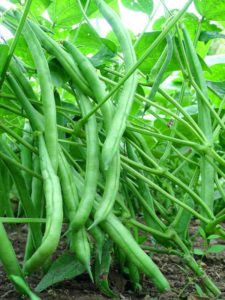 It is important to determine which characteristics of the variety are decisive in each case. This will allow you to narrow your choice and take into account the main nuances and tasks.
It is important to determine which characteristics of the variety are decisive in each case. This will allow you to narrow your choice and take into account the main nuances and tasks.
- Zoned - taking into account the climatic characteristics of a particular region: cold-resistant or thermophilic, resistant to waterlogging or dry weather, etc.
- With increased immunity to certain diseases or adapted to resist common pests (not of interest to them).
- The most suitable for a particular type of processing: freezing, conservation, long-term storage.
- By the characteristics of maturation and collection. They are divided into sugar (asparagus, pod) and shelling (grain). The latter can conditionally include universal varieties, which in an unripe form can be used in pods.
- By the type of growth - bush (determinant) and curly in long lashes (indeterminate).
- By the timing of ripening - it is divided into early (65-75 days), medium (75-90 days) and late (over 3 months).
- By color and shape of pods and grains. Beans are one of the most colorful vegetable crops. The color of the beans can be very different - yellow, purple, pink, green, white, purple and even variegated with all these shades at once. They differ in color and shape and pods, which, in combination with the possibility of vertical gardening, makes it possible to use this crop in country decor. The decorativeness of the climbing varieties perfectly complements their high nutritional characteristics.
The best bush varieties
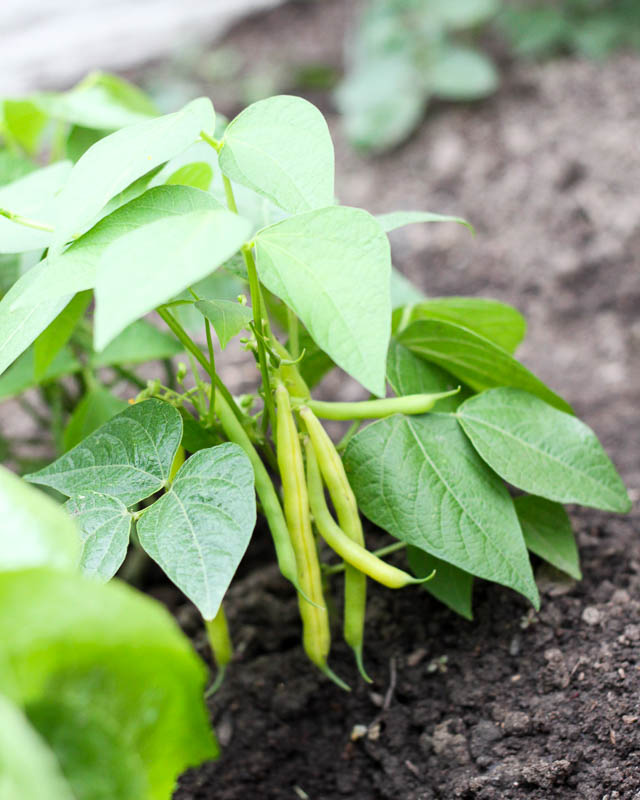
Bush varieties are the choice of supporters of a practical approach to growing vegetables. The height of the bushes does not exceed 60 cm, but usually a little less. They do not need a garter, they can not grow on a separate bed, but coexist with vegetables, enriching the soil with nitrogen for them. More resistant to cold snaps and pests than climbing species. Sugar varieties without a parchment layer have the best taste, therefore they are usually of greater interest to summer residents.
Sugar (asparagus)
- Crane - without parchment layer, unpretentious in care, fruitful. Forms compact bushes up to 50 cm. Refers to asparagus early-maturing high-protein varieties, the first pods can be plucked 1.5 months after germination. Resistant to anthracnose and ascochitosis. Suitable for freezing and preserving.
- Sachs 615 - a non-fibrous variety that allows harvesting in 50 days. A low-growing variety, does not grow more than 40 cm. Green pods saturated with sugars, up to 10-12 cm in length, have an excellent taste and are eaten whole. Stored frozen and canned. For freezing Sachs 615 is considered grade 1.
- Flamingo - mid-season (55-60 days), rather tall for a bush species - it stretches up to 60 cm. It got its tropical name for its peculiar color - bright pink-crimson painting on green. In the process of cooking, the spotting is lost, but it looks very fun and bright on the garden bed. It is unpretentious in care, has a juicy excellent taste, and is universal in purpose.
- Polka - mid-season look excellent in taste. Produces low-growing bushes, which can be harvested in 45-55 days, depending on the weather. It is prized for its resistance to bacteriosis, anthracnose, and mosaic virus. The harvest, unlike many other asparagus varieties, gives off instantly.
- Sugar triumph 764 - miniature bushes only 30-40 cm high, covered with dark green thin delicate pods without parchment up to 20 cm long. With good care, it bears fruit gradually and for a long time, even in early autumn.
- Oil king - extremely productive variety of medium late ripening. Its undoubted advantage is resistance to cold, due to which the ripening of the fruits continues until the end of September.
Read also an article on the topic: Asparagus beans: growing and care, a review of varieties, video tips
Shelling (grain)
Bushy shell beans are the most unpretentious to care for and the most versatile in relation to climatic conditions. Only grains are eaten. It is stored for a long time, does not require freezing, and when consumed requires mandatory heat treatment.
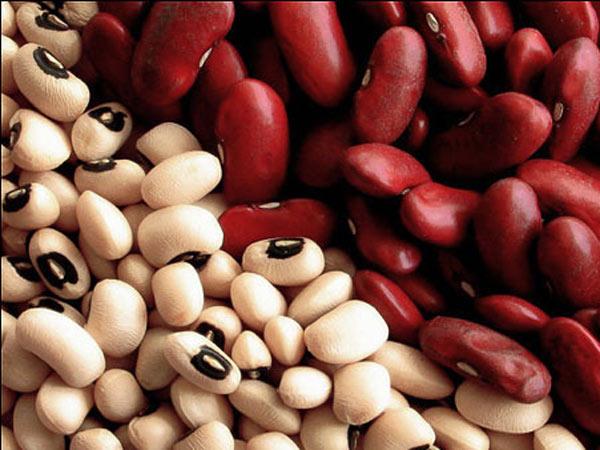
- Chocolate girl - a medium late variety, resistant to viruses and lodging, despite its high growth for bush beans. The grains are variegated, the color of milk chocolate with a white speck. Ripening and harvesting takes place in stages.
- Ruby - ripens in 80-100 days, appreciated for its high protein content. Demanding on light and soil quality, but resistant to shattering and bacteriosis infection. The grains are of a beautiful dark purple color.
- Martin - owes its name to a drawing on the fruit, similar to a burgundy dovetail on a white background. It is valued for its drought resistance, good immunity, and ease of maintenance. Cooks relatively quickly, becomes soft without violating the integrity of the shell.
The best curly varieties
The yield of these types of beans is combined with their decorative effect. Fast-growing, flowering, and then giving shoots of different colors allow you to disguise unsightly vertical surfaces, plant trees in the gazebo, and close the area from prying eyes. For splendor and a good harvest, they must be pinched, not allowing them to grow in too long lashes. It is not recommended to plant on open beds, so that later there is no need to look for poles, arcs and adapt other unsuitable objects for support.
Like bush, they can have asparagus and shelling beans.
Sugar
- Gerda - an early, very productive variety that allows you to get 4 kg of milk ripeness scoops from 1 sq. m. landing.
- Hell rem - unique in taste. Lilac-pink grains give a flavor almost indistinguishable from mushroom. High yield is an additional bonus.
- Blau Hilde - a very decorative variety with vines reaching five meters or more. Green foliage with a purple tint and colorful variegation of purple pods will decorate the site and protect more delicate crops from the wind. At the same time, Blau Hilde (there is also a solid spelling) gives an excellent harvest. It ripens for a long time, 100 days or more, so growing through seedlings is preferable in middle latitudes.
- Festival P3 - selective curly hybrid, characterized by a special length of beans - up to 35 cm. Easy to boil, suitable for conservation and freezing. Another characteristic difference from other asparagus species is longer fresh storage.
- Turk - is appreciated for its excellent vegetable "health" and productivity. Practically does not get sick with anthracnose and bacteriosis, attracts little garden pests. Can give up to 5 kg of soft green beans with raspberry veins, flat, slightly curved.
- Lambada - recommended for planting in regions with an unstable climate (return frosts, droughts). Forms very long, flat, light green beans.
Peeling
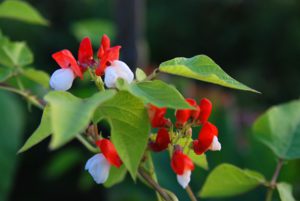 Fiery red Is a very showy variety with bright red flowers, thin stems and dense dark green greens. Afraid of the cold, but otherwise absolutely not capricious. It has varieties with white-pink and white-red inflorescences. The grains, depending on this, can be from white and pink to light purple with black specks. In an unripe form, it can be consumed with pods. More interesting from a decorative point of view.
Fiery red Is a very showy variety with bright red flowers, thin stems and dense dark green greens. Afraid of the cold, but otherwise absolutely not capricious. It has varieties with white-pink and white-red inflorescences. The grains, depending on this, can be from white and pink to light purple with black specks. In an unripe form, it can be consumed with pods. More interesting from a decorative point of view.
Spanish white - gives truly gigantic grains, 5-6 times larger than ordinary shelling beans. At the same time, it has a delicate thin skin, has a great taste, ideal for making lobio, preservation, stewing. The leaves are not eaten at any stage of maturity. The growing season under optimal conditions is 72 days.
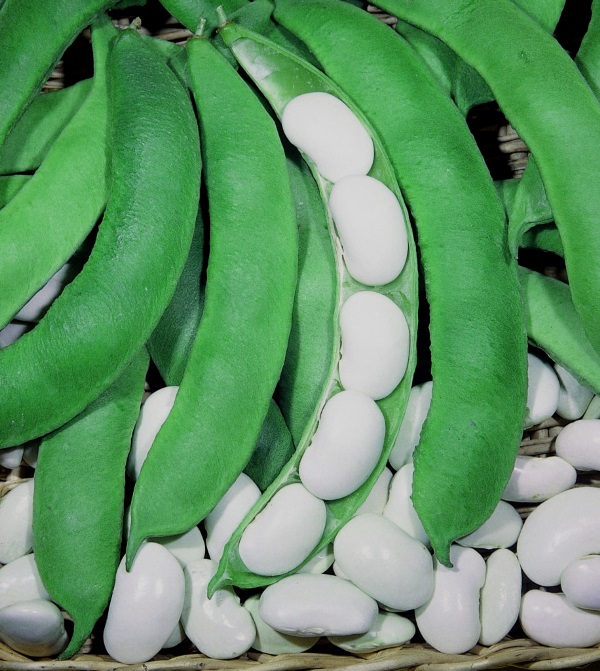
For lovers of exotic
For those who love originality, we advise you to pay attention to new breeding developments - bush varieties Yin-Yang and Fashionista with beans of unusual colors and the incredibly beautiful hybrid Purple Dream.
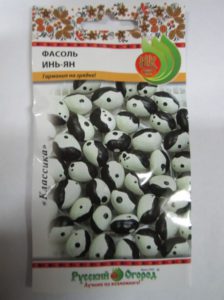 The cultivation conditions for varietal varieties of beans are generally similar. However, a bioportrait of each variety can have its own differences and cultivation characteristics, on which the entire result may ultimately depend.
The cultivation conditions for varietal varieties of beans are generally similar. However, a bioportrait of each variety can have its own differences and cultivation characteristics, on which the entire result may ultimately depend.
With a careful choice among the huge number of varieties of this vegetable crop, you can always find something that will meet both the tasks and the existing conditions.And then this motley family will not disappoint you either by the exactingness of care, or by its appearance, or by its gastronomic qualities.
Video tips for growing beans
Beans are a valuable source of protein, vitamins and microelements. When choosing a variety for planting, first of all, the method of eating the future harvest is taken into account - only grains or green pods. In addition, it is important to take into account the type of plant - bush or climbing. Some beans are intended for greenhouse cultivation, others for outdoor cultivation. The flavor, size and color of the beans are also taken into account.
In this article on our farm site, we will provide you with the best beans varieties with photo and title. The description of varieties will contain the most significant characteristics when choosing. We will help you choose a worthy variety of beans for yourself, based on the experience of experienced gardeners.
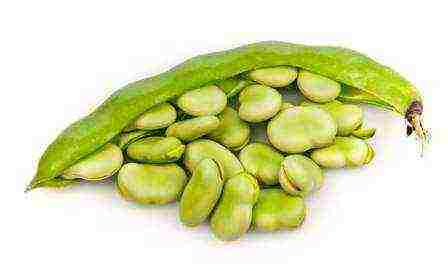
See also: When to harvest beans and how to store them correctly?
Types of beans according to the structure of the bush - photo and description
By the way the bush is arranged, types of beans are distinguished with the following names:
• Bush - compact low-growing bushes - 40-60 cm. Most of all, such beans are suitable for farmers, that is, for growing on an industrial scale. Bush beans are distinguished by early fruiting and a harmonious return of the harvest. Even harsh weather conditions are easily tolerated.
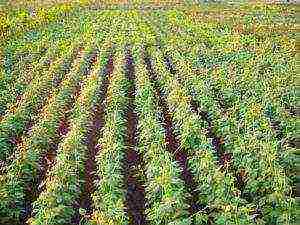 Pictured is a bush bean plantation
Pictured is a bush bean plantation
• Half-shoe Are leguminous vines that stretch 2 m in length.
• Curly - this group includes varieties with lianas branches that can reach 5 m. The advantages of climbing beans are that they save land space and decorate the site. But since her growing season is lengthened, it is not advised to grow it in cold climates in the open field.
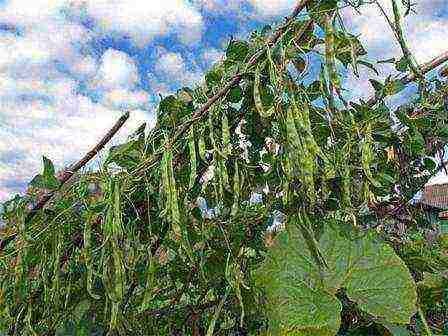 In the photo curly beans
In the photo curly beans
Types of beans by method of use - names, photos and description
Depending on the use of the crop, the following varieties of beans are distinguished:
• Peeling - only grains are eaten, the pods are too tough for use in cooking. These varieties are especially nutritious.
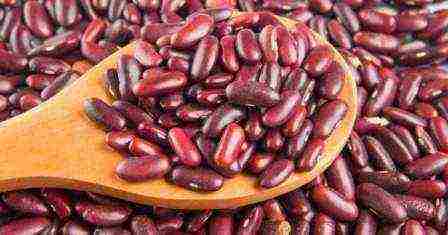 Shelling, or grain, beans
Shelling, or grain, beans
• Asparagus - grains are used together with the pod, which remains soft throughout the growing season.
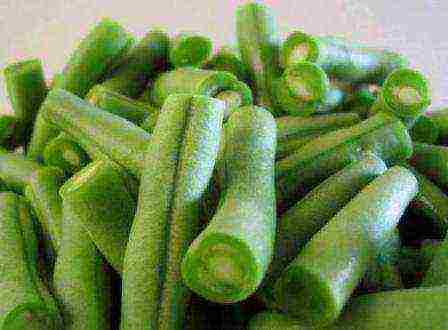 In the photo, asparagus beans, eaten along with the pods
In the photo, asparagus beans, eaten along with the pods
• Semi-sugar - until fully ripe, it is used as an asparagus, but at the end of the growing season the pod coarsens and becomes unsuitable for food.
Types of beans in appearance and nutritional value
String beans are presented in a variety of varieties that differ in color: green, yellow, purple. All varieties of hulled beans are divided into types according to the characteristics of the beans:
• Fava - dark brown beans can be eaten with the pod and, once fully ripe, without it.
In the photo, fava beans
• Vigna - the color of the beans is white with a black speck on the side. Varieties need less cooking time.
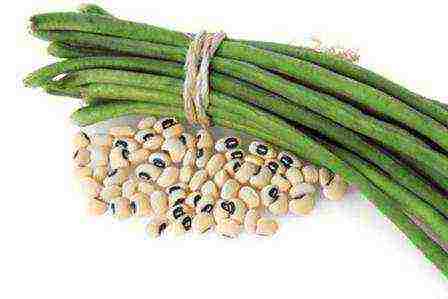 Vigna beans
Vigna beans
• Chali - large white grains with special benefits for the body.
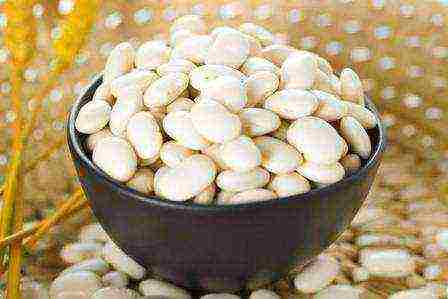 Chali beans in the photo
Chali beans in the photo
• Flajole - more often consumed with pods, the beans are green.
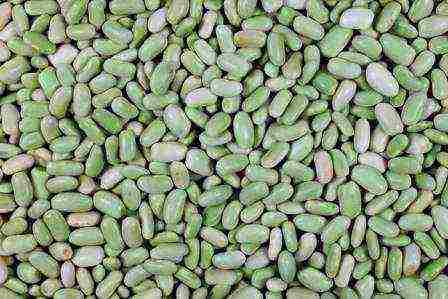 Beans Flazhole
Beans Flazhole
• Pinto - White beans with bright red spots and high iron content.
 Pinto beans
Pinto beans
• Black - small grains are dark outside and light inside; are characterized by a high protein content and antitumor effect.
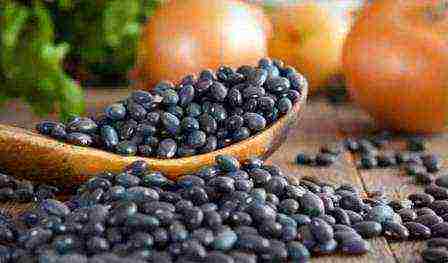 Black beans - photo matches description
Black beans - photo matches description
• Kidney - red beans.
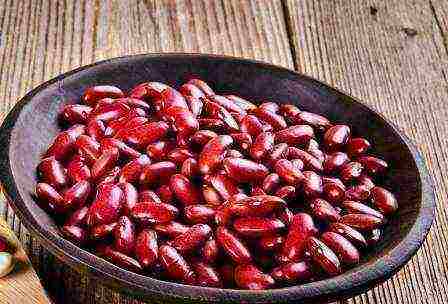 Kidney beans
Kidney beans
• Lima - large white or green grains that strengthen the circulatory system.
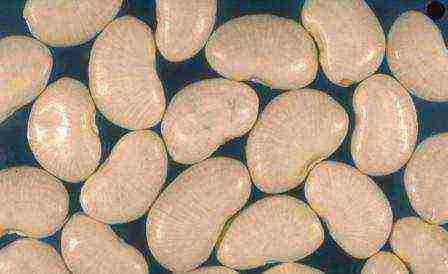 In the photo, Lima beans
In the photo, Lima beans
• Navy - small white grains, similar to beads and contain an abundance of vitamins.
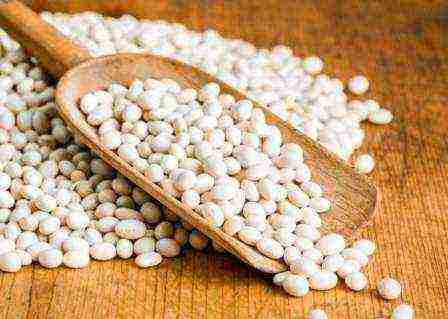 A type of beans called Nevi
A type of beans called Nevi
Popular varieties of bush asparagus beans with photos and descriptions
Asparagus beans are not yet so popular in Russia, nevertheless, gardeners have already identified some varieties that grow well in our climate.
Sachs
Compact bushes up to 40 cm in height delight with the early appearance of useful pods, the length of which reaches 12 cm. The beans are pink.
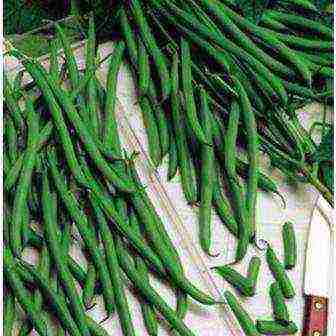 Sachs bean variety
Sachs bean variety
Oil king
A variety of beans, which is distinguished by early maturation and compactness of the bush. The pods are yellow and long - 25 cm. According to the description, this variety practically does not get sick and tolerates a lack of moisture well.
Beans Butter King by description are very oily
Purple queen
Medium ripening variety with 15 cm long purple pods for canning. Beans with this name are considered one of the most picky to grow.
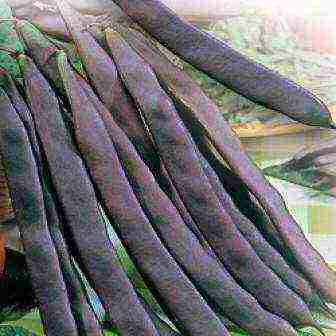 In the photo, the Purple Queen beans
In the photo, the Purple Queen beans
Panther
Beans with this name are distinguished by the average aging period and the yellow color of the pods. According to the description, it is suitable both for consumption immediately after processing and for conservation.
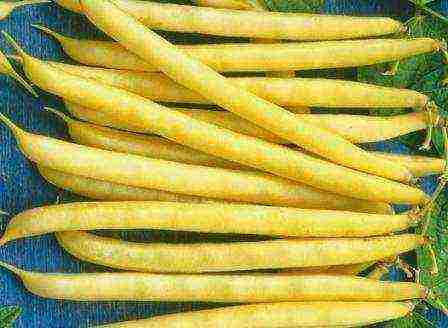
Best Asparagus and Semi-Sweet Curly Beans - Names and Photos
With the help of climbing varieties of beans, you can get not only a rich harvest, but also an excellent decoration of the land. They can be an element of decoration for a fence or gazebo. Bright and delicate flowers create a charming atmosphere on the site (see photo). Curly beans are more often grown in a greenhouse, especially in cold regions.
The names of popular varieties of sugar curly beans in Russia:
• Winner - very decorative bean with red flowers and long pods, ripening in 3 months.
 Beans of the winner variety have a high decorative effect
Beans of the winner variety have a high decorative effect
• Melody - early ripening (2 months) curly beans with medium long pods.
• Golden nectar - characterized by long yellow pods and a medium ripening rate (about 70 days).
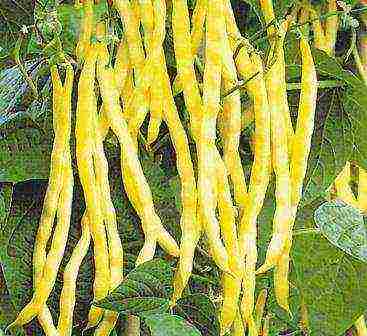
The best semi-sugar beans
Semi-sugar beans can be eaten with the pod until fully ripe and as cereal when fully ripe. The most popular are:
• Rant is the name of a semi-sugar bean with green, medium-sized pods.
• Secunda is the name of an early maturing variety with medium pods.
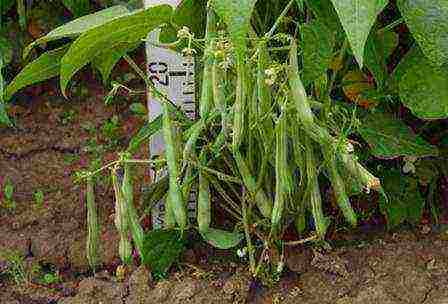 In the photo, beans of the Rant variety
In the photo, beans of the Rant variety
Grain beans - description and photos of popular varieties
Hulled beans are very nutritious and healthy. They are stored without pretreatment, and before cooking they are soaked in water for several hours. The coarse and fibrous pods of such beans are impossible to eat.
Popular varieties:
• Ruby - dark cherry grains that look very decorative.
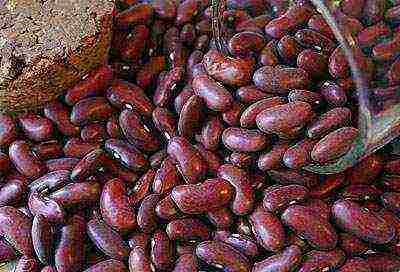 Ruby beans correspond to the name
Ruby beans correspond to the name
• Gribovskaya - white beans fully ripen in three months.
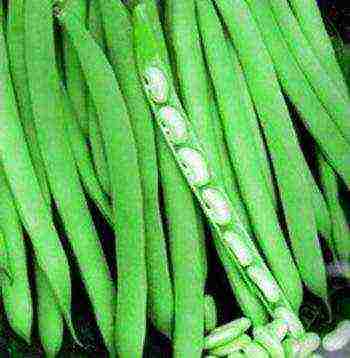 In the photo, beans of the Gribovsk variety
In the photo, beans of the Gribovsk variety
• Swallow - beans of an interesting shape, white with purple splashes.
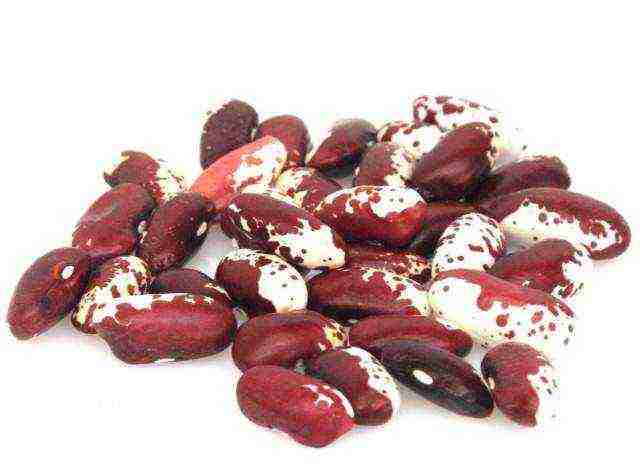
• Chocolate bar - as the name suggests, the beans are brown, the plant is very thermophilic.
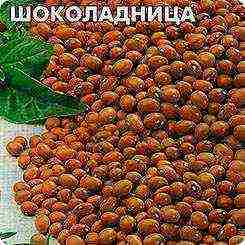
We examined the most popular varieties of beans in Russia with a photo and a name. The descriptions of the varieties contain the most important characteristics that should help you make the right choice. Remember, beans are the most valuable food product that can be completely replaced with little.
Watch the video: Types of beans. Choosing seeds! Grain and asparagus beans
Among more than 250 existing types and varieties of beans, about 50 are grown in our country. It will be interesting to get acquainted with the description of the best varieties of the most popular types of beans, their names and photos, for those who plan to grow this vegetable on their personal plot.
Shelling varieties of white beans
Beans are one of the most widely cultivated vegetables in the world. In our country, varieties that produce white beans are especially popular.
- "Inga" - bush, early, ripening for 55-65 variety of white grain beans. Beans are elongated in shape and contain up to 24% protein.
- "Uslada" - early bush grain beans with a yield of up to 600 g of grain per 1 m2. Ready for harvesting 80 days after germination, forms pods up to 16 cm long, containing 5-6 white smooth beans.
- Moskovskaya Belaya is a versatile type of beans, cultivated as a legume and shelling variety. It ripens in 100 days, the length of the green shoulder blades is 11 cm.
- "Belozerka" - mid-season white beans, medium-sized grains of which have a high sugar content.
- Black Eye is a variety of white beans with a distinctive black eye. Thanks to its thin peel and medium-sized beans, this variety boils quickly without requiring pre-soaking.
Other popular varieties of white beans: "Gribovskaya 92", "Lastochka", "White flat", "Rosinka", "Eureka", "Kharkovskaya belosemyanka D-45", "Esperanto", "Harmony".
Beans "Black Eye"
Colored varieties of grain beans
Colored beans, the grains of which have a red, black, green or variegated color, are very popular among the species diversity of beans. It is grown as a vegetable - to obtain pods, silt, as a shelling - to obtain grain, beans.
- "Limskaya" - the grains of this variety are often used at the stage of milky-wax ripeness, as they have a delicately creamy buttery taste. The color of large beans is pale green, the size of the shoulder blades is 12 cm, there are 3-4 beans in the pod. The variety ripens in 75-90 cm.
- Borlotto is a variegated variety grown for immature beans with a delicate sweetish nutty flavor, ready for harvesting within 55 days of harvesting.
- "Pink" is a curly bean variety that reaches technical maturity in 65-85 days. Beans have a characteristic kidney shape, pink color with purple streaks, up to 10 beans in a pod.
- "Gardener" - bush beans that produce variegated grain in 65 days. The color of the beans is chestnut with red spots.
- "Average Red" is a peeling red bean variety. The size of the beans is about 1 cm, the color is red-brown, the shape is round.
Other popular varieties of colored beans: "Tomato" has a brown color, "Yubileynaya 287" - variegated, white-pink, "Ethiopian" - dark red, "Violet" - light brown "," Kidney "- red," Secunda " - yellow-brown, "Nomad" - variegated purple, "Preto" - black.
Beans "Borlotto"
A selection of the best varieties of green beans
Green beans are unripe beans that use young, fleshy beans for their food. Its blades do not contain hard fibers, are versatile in use, and can be frozen and preserved.
- "Saksa" - early ripe green beans, giving the first harvest after 45-50 days. Light green shoulder blades 9-12 cm long, slightly curved, rounded -0.6 cm in diameter. The yield from 1 m2 is up to 1.6 kg.
- "Matilda" ripens in 65 days, which makes it possible to attribute it to mid-season varieties. A characteristic feature of the variety is purple pods up to 20 cm long, with a delicate taste. The powerful 3-meter climbing bean bush "Matilda", due to its high decorative properties, can also be used to decorate the site.
- "Green Giant" - medium-ripening green beans. The shoulder blades are wide - up to 3 cm, fleshy, up to 22 cm long, light green, have a delicate taste.
- "Harmony" begins to bear fruit on the 65th day with 20 cm yellow pods, giving up to 0.5 kg from one bush. The variety is curly, can be used to decorate hedges, arches.
- "Bluhilda" is a late-ripening pod variety with a 90-110 growing season. Wide purple shoulder blades reach 15-23 cm in length, change their color to green during heat treatment, have a delicate taste.
Beans "Bluhilda"
Characteristics of asparagus bean varieties
Asparagus beans are cultivated for their whole pods, which have a juicy delicate flavor slightly reminiscent of young asparagus shoots. This type of beans is presented in two varieties: a variety group that combines sugar and semi-sugar hybrids and varieties of European or American selection and Asian beans - cowpea.
one."Neringa" - a variety that gives green thick-walled pods up to 16 cm long, ready for the first harvest after 50 days. It is characterized by amicable fruiting and universal use.
2. "Sweet Courage" - early - 45-55 days bush variety with yellow, slightly curved pods 12-16 cm long. The pods are dense, crispy, cylindrical in shape and have a delicate taste.
3. "Purple Queen" forms tall bushes - 60 cm, on which, in 55 days, grow long - up to 20 cm, pods of a rich purple-violet hue.
Attention! During the heat treatment, the Purple Queen pods change their color to green.
4. “Red Podded Asparagus” is a high-yielding gourmet variety of cowpea, producing purple crunchy pods 50-80 cm long.
Beans "Sweet Courage"
5. "Spaghetti" is a variety of cowpea that forms a powerful bush that begins to bear fruit 60 days after germination. Productivity 1 kg - 5 kg of juicy pods up to 55 cm long and 1 cm wide.
Attention! A characteristic feature of cowpea is the ability to consume its pods raw.
Thanks to the successful work of breeders, gardeners on their plots can grow various varieties of beans - cereals, green beans and asparagus, many of which have excellent decorative qualities and can be used to decorate beds, flower beds and hedges.
Growing beans - video
